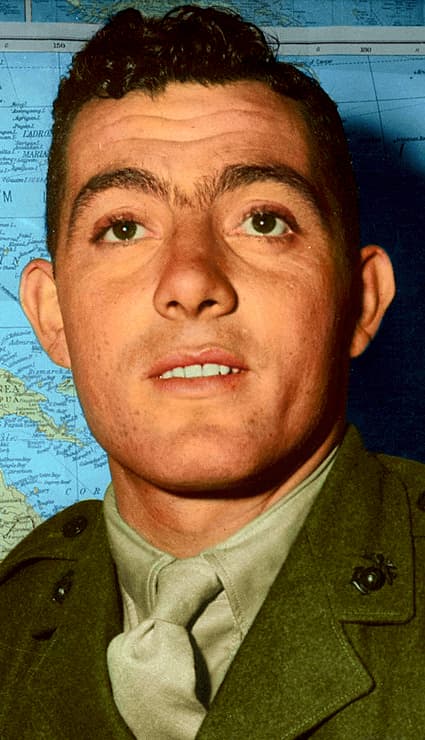Hit by Jap shell burst –
Hero of Guadalcanal killed in first wave of Iwo attack
Sgt. Basilone held Medal of Honor
By Lisle Shoemaker, United Press staff writer

Sgt. John F. Basilone
WITH THE 5TH MARINE DIVISION, Iwo Jima (Feb. 21, delayed) – Marine Gunnery Sgt. John Basilone, who won the Congressional Medal of Honor for heroism on Guadalcanal, was killed early on the first day of the assault on Iwo.
Sgt. Basilone, a handsome, dark-haired boy from Raritan, New Jersey, was in one of the early D-Day waves which swarmed ashore on this bloody, volcanic fortress island. He was, then, one of the handful of living holders of the Congressional Medal.
Sgt. Basilone led his machine-gun platoon to Iwo’s deadly beach. He was directing the platoon’s progress inland when a Jap artillery burst killed him instantly. He had been leading his men toward a spot where they could set up their guns. His last words before the shell burst were, “All right, you guys, let’s go on in there and set up these guns for firing.”
Modest, almost shy
Except under the stress of combat, Sgt. Basilone was quiet, modest, almost shy. He was extremely embarrassed whenever anyone asked him about his Medal of Honor.
Everybody who knew him said he was a tremendous asset to the newly-formed 5th Marine Division. This division, as such, went into action for the first time here. Among its personnel, however, were many veterans of other Pacific island campaigns.
Sgt. Basilone, 28, was the son of an Italian-born father. He won the Medal of Honor for action with the 1st Marine Division in the Lunga area of Guadalcanal on October 24-25, 1942.
Kills 38 Japs
The Japs made a savage and determined assault on the Marines’ defensive positions. With all but two of his men out of action firing a machine-gun and a pistol, Sgt. Basilone piled up 38 Jap bodies in front of his emplacement. He was credited with a major part in the near annihilation of an enemy regiment.
With his ammunition critically low, Sgt. Basilone fought his way through enemy lines to get and bring back bullets for his gunners.
Sgt. Basilone was born in Buffalo, New York. He served in the Army before joining the Marines. At the time of his death, he had been in the Armed Forces about eight years. In July 1944, he was married to Sgt. Lena Riggi of Oakland, California, a member of the Marine Women’s Reserve.
He was the first enlisted Marine to win the nation’s highest award for valor.